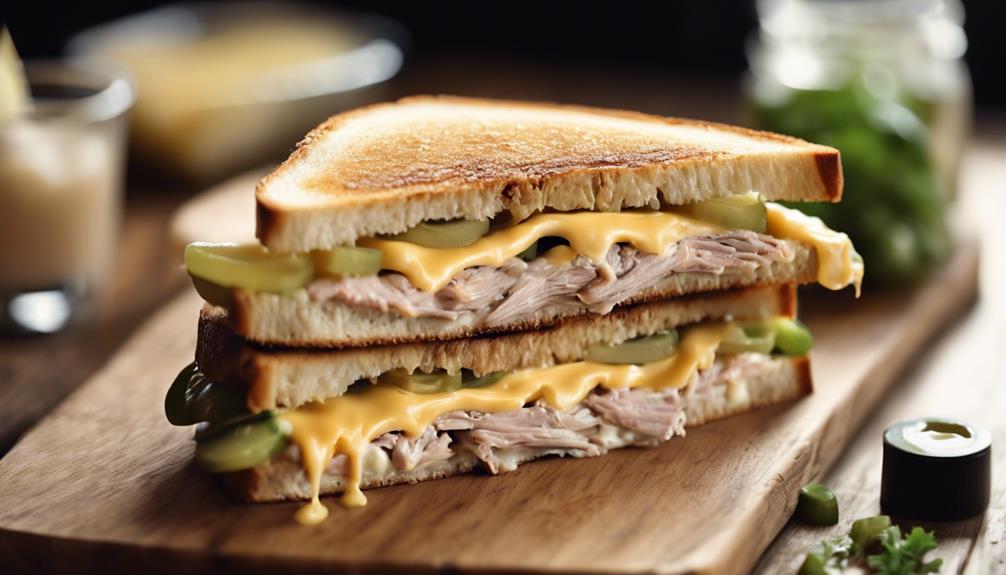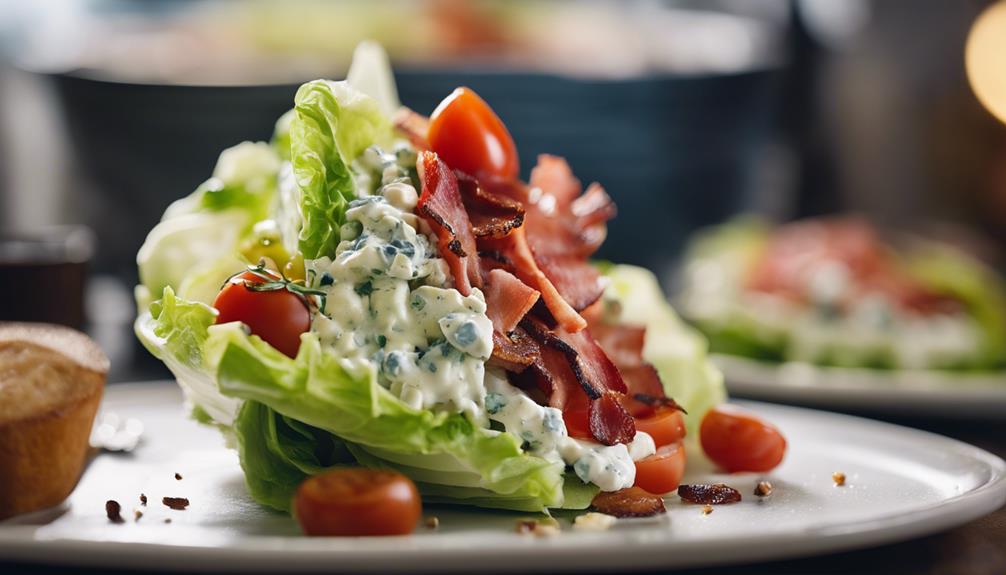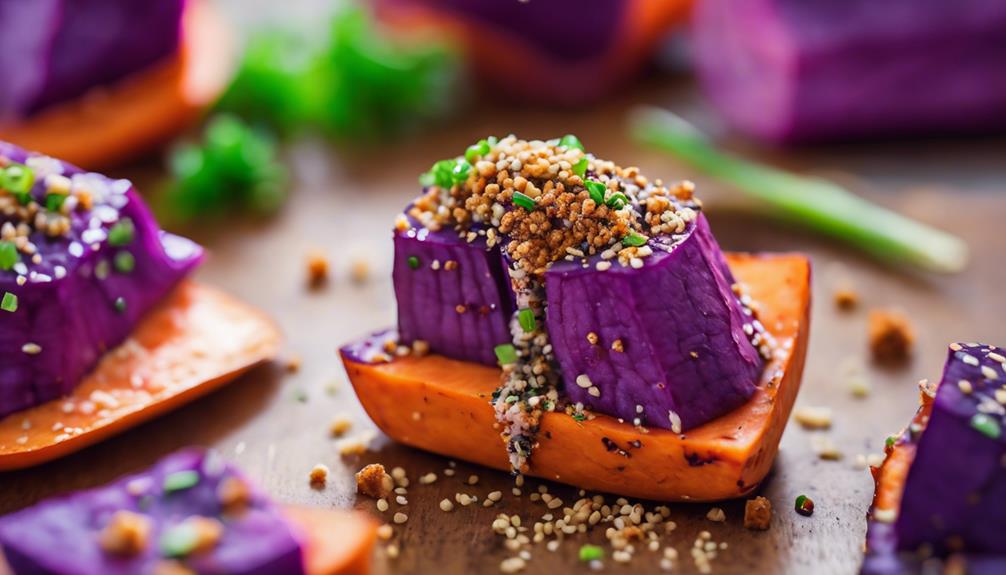Explore the rich history and delicious flavor of the timeless tuna melt. This classic comfort sandwich, with its luscious tuna blend, melted cheese, and perfectly grilled bread, offers a symphony of flavors that resonate with both tradition and coziness. Discover an array of ingredients from canned tuna to creamy mayonnaise, each contributing to its iconic appeal. Choose from a variety of cheeses like provolone or cheddar for your own twist on this beloved favorite. Learn tips for achieving that ideal toasty perfection and pairing suggestions to enhance your dining experience, making every bite a savory journey of culinary pleasure.
Key Takeaways
- Originated in mid-20th century America as a classic comfort food.
- Blend of flavors and textures makes it a beloved choice in diners.
- Features canned tuna, mayo, celery, red onion, and gooey cheese.
- Variations include vegetarian options and low-carb alternatives.
- Popular cheese choices: American, Provolone, Cheddar, Swiss, and Muenster.
Ingredients
You'll need a combination of canned tuna, mayonnaise, celery, red onion, and cheese on bread for a classic tuna melt sandwich.
The tuna serves as the key ingredient, providing a rich source of protein and a distinct flavor profile.
Mixing the tuna with mayonnaise creates a creamy base, while the addition of celery and red onion adds a satisfying crunch and a touch of freshness to the sandwich.
Cheese, an essential element in a tuna melt, contributes a gooey and savory component that pairs perfectly with the other ingredients.
When assembled on bread and grilled to perfection, the cheese melts, enveloping the tuna salad in a warm embrace that enhances the overall texture and taste of the sandwich.
These ingredients come together harmoniously in a tuna melt, offering a delightful combination of flavors and textures that make it a beloved classic in the world of sandwiches.
History
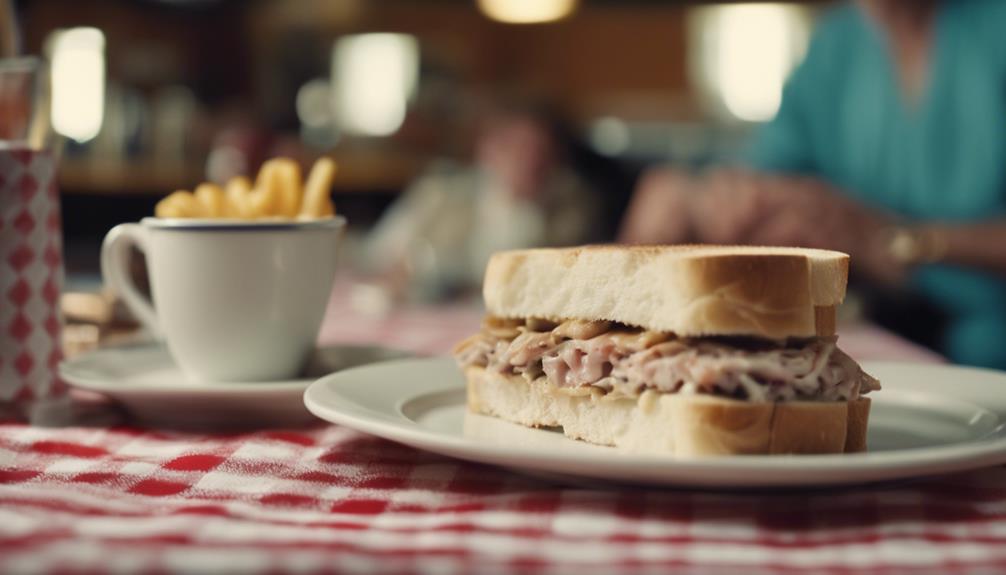
The Tuna Melt sandwich has a rich history that dates back to the mid-20th century in the United States. Over time, this classic dish has evolved to become a beloved comfort food option in diners and cafes.
Its cultural significance lies in the satisfying blend of flavors and textures that continue to make it a favorite among sandwich enthusiasts.
Origins of Tuna Melt
Originating in the United States in the mid-20th century, the Tuna Melt sandwich has since become a beloved classic in American cuisine. The origins of this iconic dish can be traced back to diners and cafes where it gained popularity as a comforting and satisfying hot sandwich option.
Here are some key points about the origins of the Tuna Melt:
- American Creation: The Tuna Melt sandwich was born in the United States, reflecting the nation's love for hearty and flavorful sandwiches.
- Mid-20th Century Emergence: This delectable creation emerged in the mid-20th century, capturing the taste buds of Americans looking for a warm and cheesy meal.
- Classic Comfort Food: The combination of tuna salad and melted cheese on bread quickly became a classic American comfort food staple, known for its warm, gooey texture and savory flavors.
Evolution Over Time
As the Tuna Melt sandwich gained popularity in diners and cafes across the United States in the mid-20th century, its evolution over time reflects a culinary journey filled with creative variations and modern adaptations.
From its humble beginnings as a warm and gooey comfort food, the Tuna Melt has experienced a transformation through the introduction of diverse ingredients and innovative cooking techniques. Over the years, chefs and home cooks alike have put their unique spin on this classic sandwich, resulting in a myriad of delicious interpretations that cater to different tastes and preferences.
Despite the numerous variations, the Tuna Melt has managed to retain its nostalgic appeal, evoking memories of simpler times and cherished traditions. Whether it's served open-faced, with added spices, or on a different type of bread, the essence of the Tuna Melt as a satisfying and heartwarming dish remains unchanged.
Its ability to adapt to evolving culinary trends while preserving its status as a beloved comfort food is a tribute to the enduring legacy of this iconic sandwich.
Cultural Significance
During the 1960s, the Tuna Melt sandwich emerged as a significant culinary icon in American gastronomy. Here are some key points highlighting its cultural significance:
- Diner Favorite: The Tuna Melt quickly gained popularity as a beloved choice on diner menus across the United States, becoming a go-to lunch staple for many.
- Comfort Food Classic: Known for its warm and cheesy tuna melt goodness, this sandwich offers a comforting and satisfying meal experience that resonates with a sense of nostalgia for many Americans.
- Global Influence: While originating in the U.S., the Tuna Melt's appeal has spread worldwide, with various regions putting their own unique spin on the classic recipe, showcasing its versatility and adaptability in different culinary landscapes.
The Tuna Melt's enduring popularity as a comforting and hearty option on the menu continues to make it a timeless favorite for those seeking a delicious and fulfilling dining experience.
Tuna Melt Variations

Explore a world of creativity and flavor by experimenting with different ingredients to create unique tuna melt variations. Enhance your traditional tuna melt recipe by incorporating variations such as capers, shallots, or green onions to add a depth of flavor.
For those looking for a vegetarian twist, consider using a chickpea tuna salad as a substitute for the classic tuna filling.
To opt for a low-carb alternative, try making bell pepper tuna melts by using bell peppers as a base instead of bread.
The possibilities for customization are endless, with opportunities to mix and match different types of bread, cheeses, and toppings to tailor your tuna melt to your preferences.
Best Cheese Choices
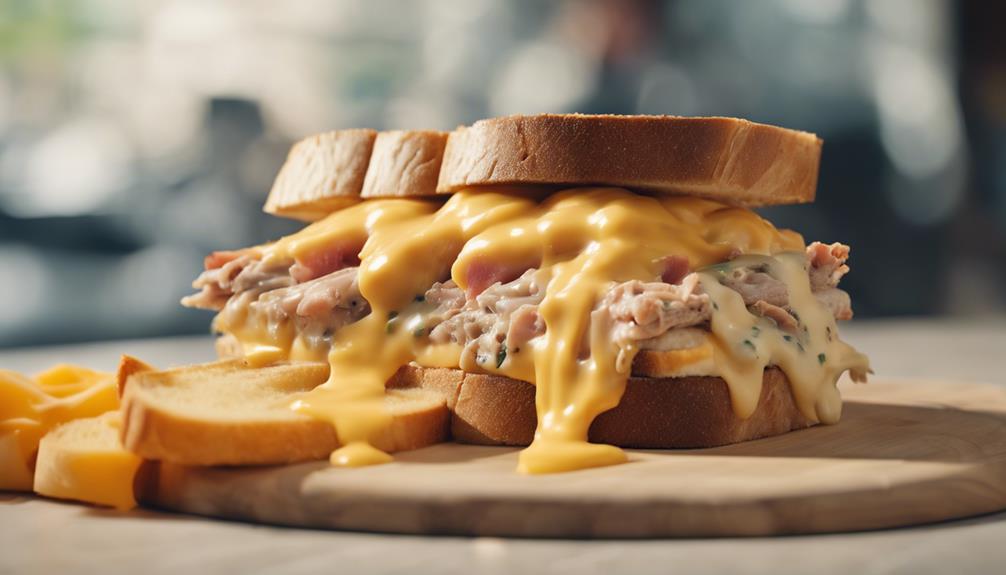
To round out your selection of cheeses for your Tuna Melt sandwich, consider the creamy meltability of American cheese as a popular choice. It provides a smooth texture and a mild flavor that complements the tuna perfectly.
Additionally, Provolone cheese adds a tangy and nutty taste, enhancing the overall flavor profile of the sandwich. Cheddar cheese, known for its sharp and rich flavor, brings a bold kick to the Tuna Melt, making each bite a delight for your taste buds.
Swiss cheese, with its nutty and slightly sweet notes, provides a unique twist to the classic sandwich, elevating it to a new level of deliciousness. Finally, Muenster cheese, famous for its melt-in-your-mouth texture, adds a creamy and mild taste that blends harmoniously with the other ingredients, creating a gooey and satisfying experience.
Experiment with these cheese choices to find the perfect combination that suits your palate and makes your Tuna Melt truly exceptional.
Tips for Perfect Toasting
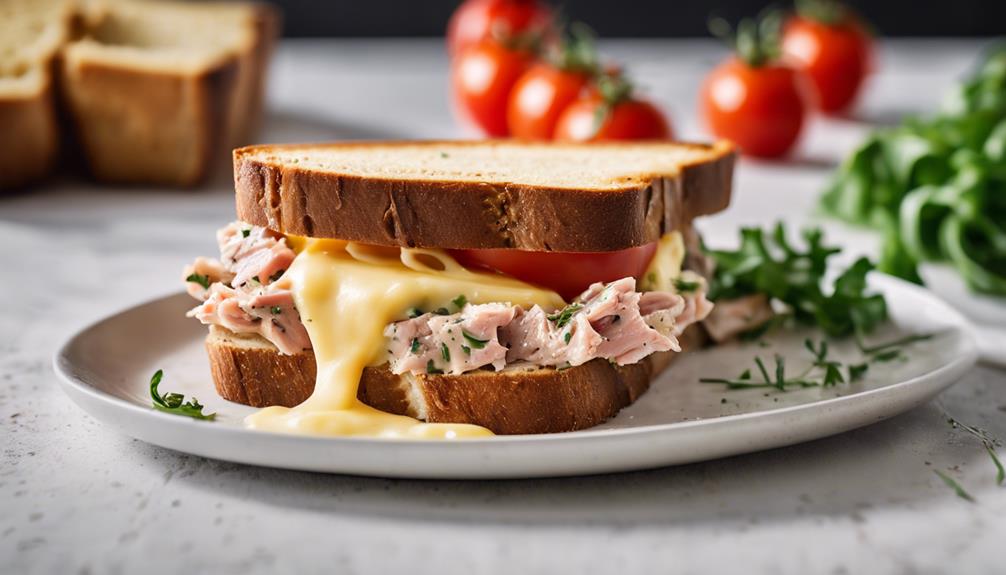
When perfecting the toasting of your Tuna Melt Sandwich, keep in mind that bread choice matters – opt for a sturdy option that can hold the filling.
Make sure you evenly spread the ingredients to guarantee a balanced bite in every mouthful.
Maintaining the right temperature while toasting is key to achieving that ideal golden crunch without burning the bread.
Bread Choice Matters
For the perfect Tuna Melt sandwich, choosing the right bread is crucial to guarantee a satisfying crunch and gooey melt. When it comes to bread choice, consider opting for a sturdy option like sourdough or Pullman. These types of bread provide a solid foundation that can hold the flavorful tuna filling without becoming soggy.
Additionally, selecting bread slices that aren't too thick ensures that the toasting process will be even, allowing the cheese to melt uniformly throughout the sandwich.
To enhance the overall taste and texture of your Tuna Melt, make sure to generously butter the bread slices before assembling the sandwich. This step not only adds a rich flavor but also helps achieve a crispy and golden exterior when toasted.
Evenly Spread Ingredients
To achieve the best toasting results for your Tuna Melt sandwich, evenly spread the tuna salad mixture on the bread slices. Ensuring an even distribution of the salad is vital in creating a well-balanced flavor profile in each bite. Proper layering of the tuna salad and cheese helps prevent one side of the sandwich from being overloaded, leading to uniform melting of the cheese and enhancing the overall texture. A well-distributed filling promotes a cohesive and delicious Tuna Melt experience with every bite.
| Tips for Evenly Spreading Ingredients |
|---|
| 1. Start with a generous amount of tuna salad. |
| 2. Spread the salad to the edges for consistent flavor. |
| 3. Layer cheese evenly over the salad for uniform melting. |
| 4. Ensure both bread slices have a well-distributed filling. |
| 5. Press the sandwich gently before toasting for compactness. |
Right Temperature Is Key
Maintaining the appropriate temperature while toasting your Tuna Melt sandwich is crucial for achieving the perfect balance of crispiness and gooeyness. To guarantee your sandwich turns out just right, follow these tips for perfect toasting:
- Toast Temperature: Set your cooking appliance to medium-low heat to prevent burning and allow for even toasting. This gentle heat will help achieve a crispy exterior without overcooking the bread.
- Crispy Exterior: Cooking your Tuna Melt at the right temperature will result in a satisfyingly crispy exterior that complements the creamy filling. Adjust the heat level as needed to avoid overly crispy or charred bread.
- Cheese Melting: Proper toasting not only crisps up the bread but also ensures that the cheese inside melts to a gooey, indulgent consistency. The ideal temperature allows the cheese to slowly melt while the bread achieves the desired level of toastiness.
The Perfect Side Dishes
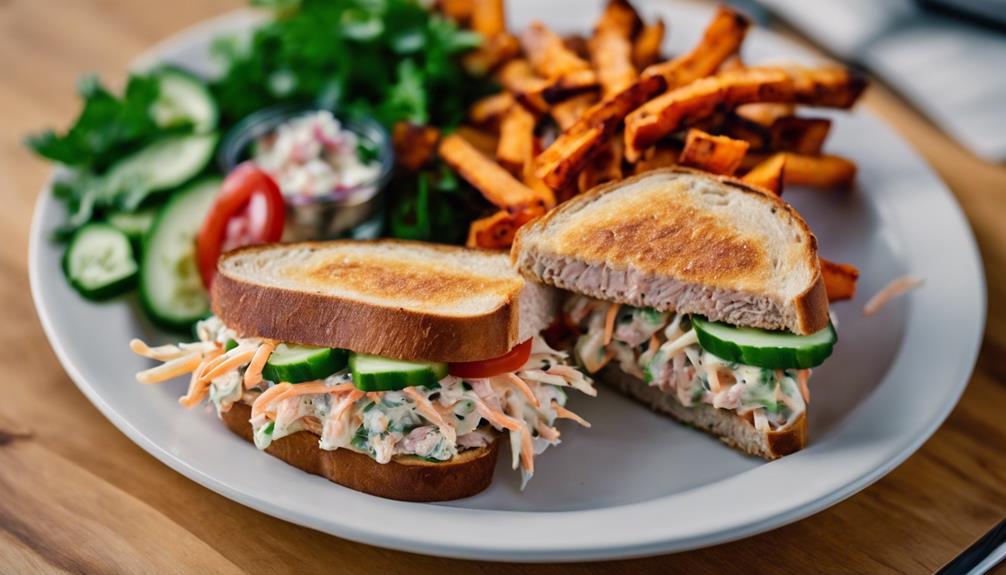
Enhance your Tuna Melt experience with a selection of perfect side dishes that complement its flavors and textures.
Classic tuna companions such as potato chips, dill pickles, and coleslaw provide a satisfying crunch and tangy contrast to the savory goodness of a Tuna Melt.
For those seeking a bit of heat, consider serving pickled peppers or jalapeños alongside your sandwich for a spicy kick.
To add a touch of sweetness to your meal, opt for a side of bread and butter pickles, balancing out the richness of the dish.
For an invigorating option, a zesty arugula salad can provide a crisp and fresh contrast to the hearty Tuna Melt.
Additionally, potato salad or a side of air fryer French fries can further enhance the flavors of the sandwich, offering a comforting and fulfilling meal experience.
Choose your side dishes wisely to elevate the classic comfort food appeal of your Tuna Melt.
Serving Suggestions
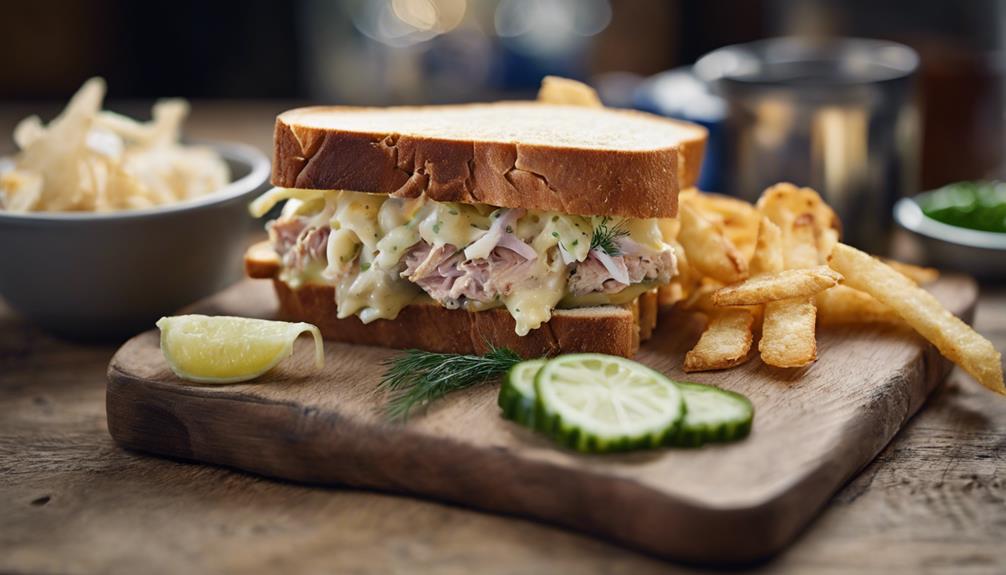
Consider pairing your Tuna Melt sandwich with an invigorating side salad to balance the richness of the dish. This combination offers a revitalizing contrast to the warm, cheesy goodness of the tuna melt.
Additionally, you can enhance your dining experience by including classic accompaniments that complement the flavors of the sandwich. Some popular choices include:
- Dill Pickles: The tanginess of dill pickles adds a crisp and flavorful element that cuts through the creaminess of the tuna melt.
- Kettle-Style Potato Chips: The satisfying crunch of kettle-style potato chips provides a textural contrast to the softness of the sandwich, creating a delightful sensory experience.
- Hot Sauce: For those who enjoy a bit of heat, a drizzle of hot sauce can elevate the flavors of the tuna melt, adding a spicy kick to each bite.
These serving suggestions aim to enhance your enjoyment of the classic and comforting Tuna Melt sandwich, offering a well-rounded meal that satisfies both your taste buds and appetite.
Healthier Ingredient Swaps
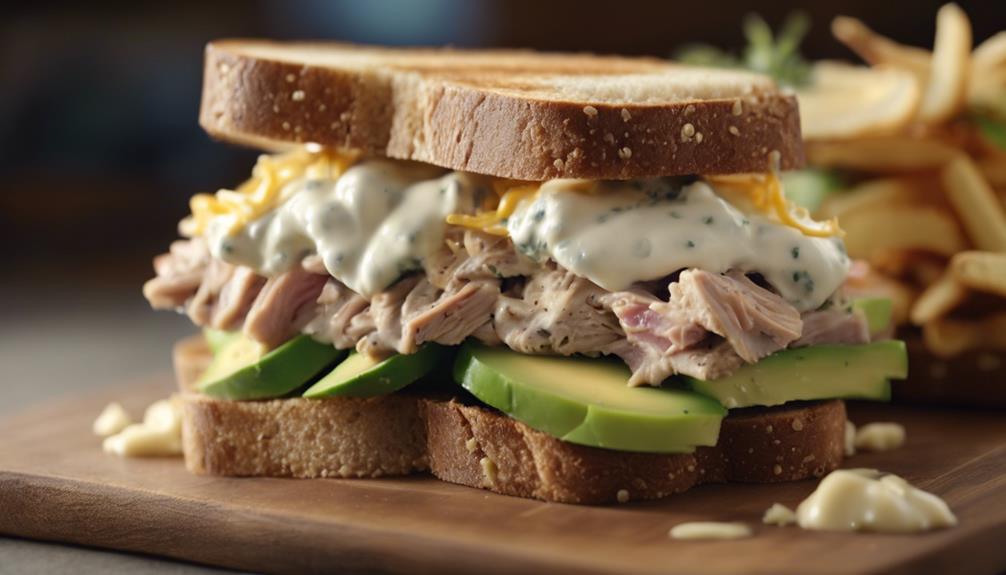
To make your Tuna Melt sandwich healthier, consider swapping out traditional ingredients with lighter alternatives that reduce calorie and fat content. Instead of regular mayo, opt for a healthier alternative like Greek yogurt or avocado spread to cut down on calories and saturated fats.
Replace white bread with whole grain or whole wheat bread to boost fiber and nutrient intake. Choose low-fat or reduced-fat cheese options over full-fat cheese to lessen saturated fat consumption while still enjoying that cheesy goodness.
Enhance the flavor profile of your Tuna Melt by incorporating fresh herbs and spices such as parsley, dill, or smoked paprika. These additions bring a burst of taste without adding extra calories or unhealthy fats.
Additionally, using water-packed tuna instead of oil-packed tuna can notably decrease the overall calorie and fat content of your sandwich. By making these simple yet effective healthy swaps, you can enjoy a lighter and more nutritious Tuna Melt without compromising on taste.
Tuna Melt Hacks
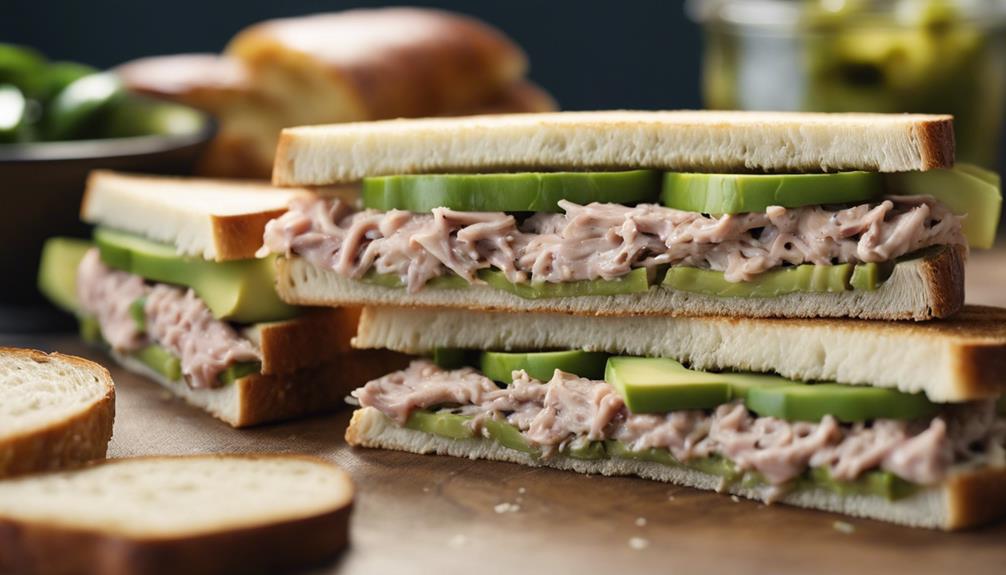
To elevate your tuna melt game, consider swapping mayo for hummus for a smoother consistency.
Or try green olives instead of capers for a unique flavor profile.
Opt for green onions and extra celery to steer clear of potential migraine triggers.
Crisp up your tuna salad in the pan before assembling your sandwich for extra texture.
Experimenting with cheeses like mozzarella, Swiss, or Gruyère can add a delightful twist to your classic tuna melt.
Flavorful Tuna Fillings
Revamp your tuna melt game with these flavorful tuna fillings that will take your sandwich to the next level.
- Enhanced Tuna Salad Recipe: Elevate your canned tuna by mixing it with mayo, lemon juice, red pepper flakes, celery, pickles, red onion, and parsley. This vibrant combination adds depth and complexity to your tuna salad, ensuring each bite bursts with flavor.
- Cheese Variety: Experiment with a range of cheeses such as cheddar, provolone, Swiss, or Gruyère to complement the tuna. When melted, these cheeses create a gooey, indulgent layer that perfectly pairs with the hot sandwich.
- Spicy Options: For those craving heat, consider adding pickled jalapeños or a drizzle of hot sauce to your tuna salad mix. These spicy elements provide a zesty kick that enhances the overall taste profile of your tuna melt.
Melty Cheese Perfection
Enhance your tuna melt experience by mastering the art of achieving melty cheese perfection with these Tuna Melt Hacks. When it comes to creating that gooey and fully melted cheese layer on your tuna melt, choosing cheeses with good melting properties is essential. Cheeses like American, cheddar, or provolone are ideal for achieving the desired melty cheese perfection. These soft, young cheeses provide a creamy texture that enhances the overall experience of the sandwich.
To take your tuna melt to the next level, consider experimenting with different cheeses to discover unique flavor profiles and textures. Mixing and matching cheeses can add a creative twist to the classic tuna melt while still ensuring that melty goodness. Remember, when cooking your tuna melt, maintaining medium-low heat is important. This ensures that the cheese melts evenly, creating a luscious and indulgent layer without burning the bread.
| Cheeses with Good Melting Properties | Creamy Texture | Experimenting with Different Cheeses |
|---|---|---|
| American | Creamy | Adds Unique Flavors |
| Cheddar | Smooth | Enhances Texture |
| Provolone | Rich | Creates Melty Goodness |
Popular Tuna Melt Combinations
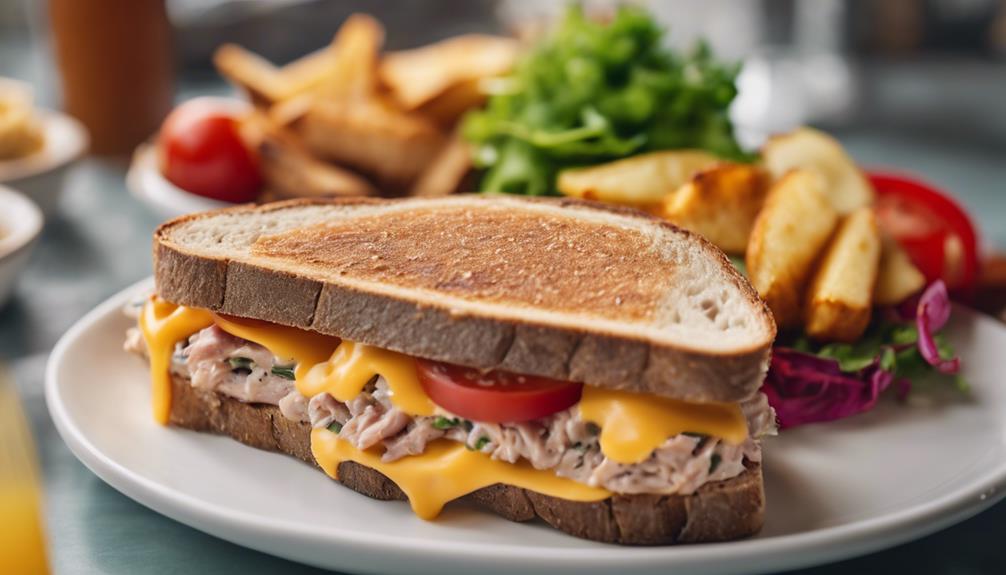
You can elevate your Tuna Melt experience by experimenting with popular combinations that enhance its flavor profile. Here are some tried-and-true options worth exploring:
- Swiss or Cheddar Cheese: Opt for Swiss or cheddar cheese for that classic gooey, melty goodness that perfectly complements the tuna.
- Sliced Tomatoes, Red Onions, or Pickles: Add a burst of freshness and tanginess by including sliced tomatoes, red onions, or pickles in your Tuna Melt. These classic additions provide a nice contrast to the rich tuna and cheese.
- Avocado Slices, Bacon, or Paprika: For a unique twist on the traditional Tuna Melt, try incorporating avocado slices, crispy bacon, or a sprinkle of paprika. These variations can bring new depths of flavor to your sandwich, making it a delightful culinary adventure.
Frequently Asked Questions
What Goes Well With a Tuna Melt?
When enjoying a Tuna Melt, pair it with classic sides like potato chips and dill pickles for a satisfying crunch. For a heartier meal, consider coleslaw or a green salad to complement the flavors.
What Is a Tuna Melt Sandwich Made Of?
Imagine crafting a tasty delight! A Tuna Melt sandwich: It's crafted with canned tuna, mayo, veggies like celery, onion, and cheese. Spread the mix on bread, top with cheese, then toast until melted. Delicious!
What Kind of Cheese Goes With Tuna?
When pairing cheese with tuna, opt for soft varieties like American or Provolone for gooey perfection. Experimenting with different cheeses can enrich your Tuna Melt experience, offering a range of flavors to enjoy.
Why Is a Tuna Melt so Good?
When you bite into a Tuna Melt, flavors dance on your taste buds like a symphony. Creamy tuna salad, gooey cheese, and crispy bread harmonize perfectly, offering a comforting indulgence that satisfies your cravings.
Can I Substitute Tuna in a Tuna Melt with a Vegan Option in the Caprese Pizza?
Yes, you can substitute tuna in a tuna melt with a vegan option in the caprese pizza. Simply follow a vegan caprese pizza recipe and use plant-based tuna or other vegan protein options as a substitute for the tuna. Enjoy a delicious and cruelty-free alternative to the classic tuna melt.
Conclusion
Indulge in the timeless taste of a tuna melt, a delectable dish sure to satisfy your comfort food cravings.
With a variety of ingredients and toppings to choose from, you can customize this classic sandwich to suit your tastes perfectly.
So why wait? Whip up a warm and cheesy tuna melt today for a delicious and hearty meal that's sure to please even the pickiest of eaters.
